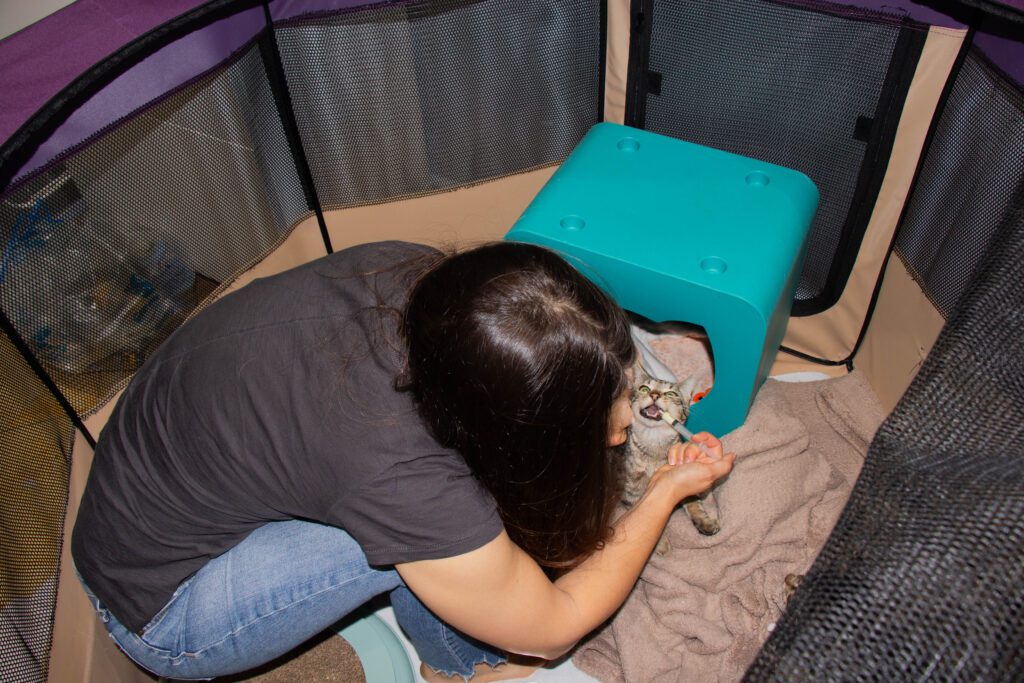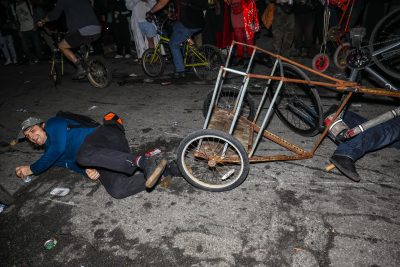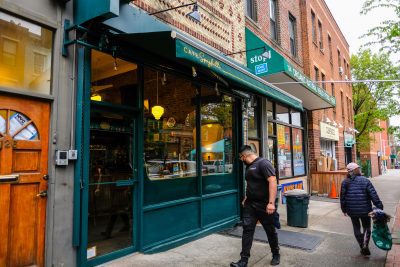Olga Gudyno photographs a rescued kitten to put up for adoption (Photo by Muskan Nagpal)
Stray cat blues: ‘It’s worse now than ever’
Brooklyn cat rescuers face an uphill battle as resources disappear amid a post-pandemic boom of strays
Dozens of stray cats peer out from the bushes surrounding Ann Charles’ backyard, hungry. The 77-year-old Canarsie resident began feeding a single stray cat with a couple kittens when they showed up at her door four years ago. Apparently, word got out. Now, Sassee Walker is here to help, setting up traps on Charles’ concrete patio.
The first trap drops within minutes. Then another, and another. Several cats, including a 4-month-old kitten, are pregnant.
“Oh, you caught the little one, I’m glad!” Charles says as Walker transfers the kitten to a smaller trap. The cats will go to the Brooklyn Cat Café clinic in Brooklyn Heights to be spayed, neutered, vaccinated and put up for adoption if they’re friendly. “Well, you can be glad for all of them,” says Walker. “Because we’re not leaving none of them behind.”
Walker, 53, is one of many certified cat rescue volunteers in New York City and one of few active in East New York. Outside her full time job for a New York City hospital, she cares for several cat colonies and helps local feeders like Charles curb the number of cats roaming their neighborhood. Her two-bedroom apartment is perpetually filled with feral cats recovering from or awaiting spay or neuter appointments, and “friendlies” waiting for their foster or forever home. In over a decade of doing this work, Walker says, “It’s worse now than it’s ever been.”

Trapping backyard strays in Midwood (Photo by Muskan Nagpal)
Hunger games
New York City began relying on volunteers like Walker to control the feral cat population when it switched from a trap-to-kill to a TNR (trap, neuter, return) approach. In 2005, the Mayor’s Alliance for NYC’s Animals launched the NYC Feral Cat Initiative. At least 8,000 volunteers became certified through free workshops, learning how to trap, fix and eartip (snipping the left ear tip to indicate a cat has been TNR’d) feral cats. Once certified, these volunteers could access low-cost spay, neuter and vaccination appointments; free transportation services; and free loans for traps and other equipment.
In 2011 — the year Mayor Michael Bloomberg signed Local Law 59, endorsing TNR as the official and recommended method of controlling New York City’s feral cat population — a new ASPCA location in Glendale, Queens, dedicated solely to servicing the city’s TNR volunteers opened its doors. This September, that clinic’s lease ran out, and it closed. Although the ASPCA intends to add staff and appointments to its New Lots location until a new Queens facility opens sometime next year, rescuers fear the potential impact. Especially as it comes in the wake of other resources disappearing and a particularly “brutal” kitten season.
With an estimated 500,000 cats out on the streets of New York, working quickly — and on a large scale — is paramount to making TNR work. Unspayed cats can have up to four litters a year, and kittens can get pregnant within several months. A pandemic closure of spay/neuter clinics, followed by a spike in cats put on the street by their owners, has led to a boom in outside cats. But even though TNR and rescue volunteers are ready to act, resources are lacking.
“Booking ASPCA appointments has turned into the Hunger Games,” says Kyla Burton, a cat rescuer from Bed-Stuy who specializes in kittens. Newly certified volunteers can’t sign up for appointments at all. Those who can, have to be at their computer at 6 a.m. sharp on the day the calendar opens for the next month, ready to pounce. “Last month, I got five appointments, but I had 11 cats that needed fixing,” says Burton. Spay/neuter surgeries and vaccinations at the ASPCA are free, although most rescuers add a flea treatment, an FIV/FELV test and a microchip for $45. Burton adds that if she took the cats to a vet to be spayed or neutered, it could cost her upwards of $1,000 per cat.
In an email to rescuers in late August, the ASPCA acknowledged their limited availability: “In total, there are approximately 1,027 appointment spots available for all of September. … Please keep in mind that with over 1,500 rescuers eligible to schedule appointments, these spots fill within seconds of the calendar opening. While we know this is frustrating, please understand that both the ASPCA and your fellow rescuers are all working towards the same goals to save animals and spay and neuter as many dogs and cats as possible.”
Sassee Walker admits she doesn’t even attempt to book through the ASPCA: “I’m lucky if I get any; other people are better at that.” Her cats go to the clinic at Brooklyn Cat Café, which offers reduced fares for rescuers and pet owners and tries to make spots available for Walker. Through Bideawee, the NYC Feral Cat Initiative added over 700 free and low-cost spay/neuter surgeries per year from two mobile clinics following the pandemic. Another affordable clinic called Flatbush Vets opened this summer. Still, these organizations are stretched to their limits. “I thank God that Brooklyn Cat Café is willing to work with me,” says Walker. “Just with Ann Charles, that was 29 cats.”
Dumped house cats
Olga Gudyno has been managing the stray cat population in her Midwood neighborhood for several years. Last year, she TNR’d 83 cats and rescued 67, she says after checking her notebook. “This year, it’s already been nearly 100 just for TNR.” Because she finances this all out of pocket, any help means a lot. But over the years, she’s seen several local services disappear, including a mobile clinic and free transportation services.
Gudyno, 33, used to drop cats off in Dyker Heights for free transport to the ASPCA in the morning, allowing her to go to work and pick them up after. “That service stopped about a year ago,” she says. According to a schedule on their website, the ASPCA still offers spay/neuter transport services in the Bronx, Manhattan and Staten Island, but no longer in Brooklyn. Now Gudyno usually asks a friend for a ride, or takes an Uber.


Olga Gudyno administers medicine to a rescued kitten (Photo by Muskan Nagpal)
Gisel O’Donoghue, who rescues and TNR’s over 100 cats per year and manages several colonies near her Starrett City home, has grown especially worried about the number of friendly house cats being dumped in her neighborhood. High veterinary costs have led more people to surrender or abandon their cats. City shelters are also feeling the pressure: the Animal Care Centers (ACC) closed for cat intakes this June due to overcrowding. “I’ve seen so many terrified cats left in boxes or carriers lately,” says O’Donoghue, 40. Although she’d like to get them all off the street, she says she’s limited to having fosters lined up. Her own apartment is already full.
Dumped house cats also disrupt TNR efforts. Gudyno mentions she recently saw a woman dump four unspayed females on the corner of her street. She wanted to take them in but didn’t have any appointments lined up. Keeping them in her apartment in the meantime wasn’t an option — she already has nine friendly cats that she couldn’t find a permanent home for, several rescues awaiting adoption, and quarantined cats waiting for surgery in her spare bathroom and laundry room. “Now three of those dumped cats are pregnant,” says Gudyno, adding that she still doesn’t have room but might trap them before their kittens are out on the street too.


Olga Gudyno feeds a few of the rescued cats at her home (Photo by Muskan Nagpal)
While many rescuers are struggling to keep up, looking away isn’t an option. “Only people who really care about animals do this work,” says Burton. “And they tend to be emotionally involved.” Some have begun putting veterinary costs they can’t cover through crowdfunding on their credit cards, or are dipping into their savings.
Many wish there was some sort of funding or governmental support for their work, since they’re addressing a citywide problem. In an email to Brooklyn Magazine, the ASPCA echoes the sentiment: “We thank rescuers for their hard work, dedication, and collaboration, and we will continue advocating for the City Council to increase funding to support their lifesaving efforts. ASPCA programs and services are not meant to replace municipal services, and the City must properly fund its Animal Care Centers to ensure they can provide critical resources, including spay/neuter surgeries, to the community.”
Despite the many sacrifices she makes, including her free time, her money and her personal space, Sassee Walker plans to keep doing the work. Still, she’s had to remind herself of the role she’s actually playing. “We take on this issue so much, we forget we’re not the ones responsible,” she says. “But we didn’t put the problem there. We’re just trying to fix it.”
You might also like 


























